The Częstochowa Jewish Cemetery's History
by WIESŁAW PASZKOWSKI, Częstochowa Municipal Museum, History Documentation Centre
and ALON GOLDMAN, Chairman of the Association of Częstochowa Jews in Israel
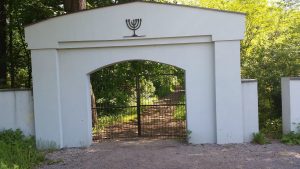
The Czestochowa Jewish cemetery was established in 1808 outside the city limits, on the right bank of the Warta River, near the village of Kucelin. Prior to this, the Jews of Czestochowa had been buried in Janów.
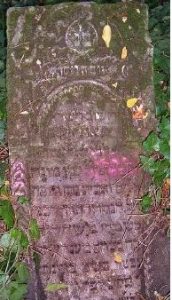 It is the third largest Jewish cemeteries in Poland, mostly covered with forest and thick vegetation. It has an area of 9.5 dunams with around 4,500 tombstones from the 19th and 20th centuries having been preserved. The earliest tombstone that has been found dates back to the beginning of 19th century, 1810, that of Moshe David Ben Menachem Mendel (Hermanowicz) z”l. The last burial took place here in 1973.
It is the third largest Jewish cemeteries in Poland, mostly covered with forest and thick vegetation. It has an area of 9.5 dunams with around 4,500 tombstones from the 19th and 20th centuries having been preserved. The earliest tombstone that has been found dates back to the beginning of 19th century, 1810, that of Moshe David Ben Menachem Mendel (Hermanowicz) z”l. The last burial took place here in 1973.
 Most of the tombstones were made of sandstone and limestone. Some of them have colors: red, black, yellow and gold. They have Hebrew and Polish inscriptions.
Most of the tombstones were made of sandstone and limestone. Some of them have colors: red, black, yellow and gold. They have Hebrew and Polish inscriptions.
The Rebbe of Piltz, Pinchas Menahem Eliezer Justman, who died in 1920, is buried in this cemetery. Each year, many Hasidim from all over the world come to his grave and the son of the righteous Yitzchak Meir Justman is also buried in this ohel. Signs on trees – “השפתי צדיק” – point the way to his ohel.
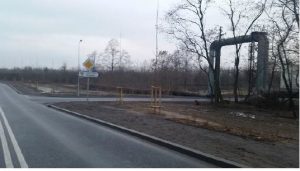 The area of the cemetery was enclosed by a brick wall. The boundaries of the cemetery are preserved, despite the fact that the wall surrounding the cemetery is mostly destroyed. The entrance to the cemetery is marked on both sides of the road.
The area of the cemetery was enclosed by a brick wall. The boundaries of the cemetery are preserved, despite the fact that the wall surrounding the cemetery is mostly destroyed. The entrance to the cemetery is marked on both sides of the road.
Users of Waze or GPS should be directed to the following street: ul. Odlewnikow. When reaching the sign to the cemetery, turn in the direction of the sign, under the water pipe to the the dirt road, ul. Złota, until you reach the parking lot in front of the cemetery.
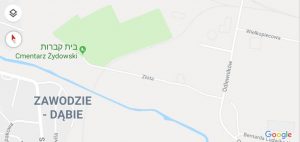
During World War II, the cemetery was partially destroyed. Some of the gravestones were uprooted by the Germans and used for construction purposes. In the cemetery, the Germans carried out many executions of Jews from the local Ghetto and from the HASAG Forced Labor Camp. Men, women, and children, deemed unfit for work, were executed there. The bodies of Jews of those who were murdered in the city, during the War, were buried throughout the city. When the War ended, their bodies were transferred to a permanent grave in the cemetery.
The road into the cemetery leads to a square in the centre of the cemetery. It is here. you can find the grave of Rabbi Nachum Asz, who was the Chief Rabbi of Częstochowa and seven mass-graves and monuments. On the way, to the right, you pass the ohel of the Rebbe of Piltz.
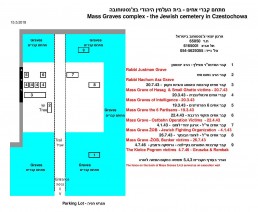
At the end of WWII, the local populace stole the most precious gravestones from the cemetery. In 1950, the Polish authorities decided to include the cemetery within the area of the metal factory Huta Częstochowa. From that moment, access to the cemetery was difficult and limited. Despite the initial fears about the preservation of the cemetery, it turned out that the decision to limit access saved the Częstochowa Jewish Cemetery from further destruction. However, the ravages of time have taken their toll and the cemetery has been subjected to progressive deterioration. Most of the wall around the cemetery, about 1 km long, has been damaged, vegetation has spread and has covered the graves. Many trees have grown in the area and, later, bad weather conditions have caused these trees to collapse.
In 1984, with the assistance of the Nissenbaum Family Foundation, the wall in front of the cemetery and the entrance gate were renovated. In 1986, the cemetery was placed on the list of sites for preservation by the Polish government. The Chevra Kadisha lists were lost and or destroyed during the WWII.
In 1986, the Jewish cemetery in Częstochowa was declared a national heritage site.
Poles carried out the first mapping of the cemetery in 1970.
Between the years 2008 AND 2016, a mapping project was conducted by Reut High School students from Jerusalem, led by the educator Ms. Dina Wiener, in cooperation with the Association of Czestochowa Jews in Israel. Its its results were published on the website http://www.gidonim.com/.
The last official burial in the cemetery was that of Albert David z”l which took place on 3rd May 1970. Up until 1973, there were also some “illegal” burials .
On the basis of the first mapping made by Poles in 1970, for many years, historian Wiesław Paszkowski of the Czestochowa Museum Documentation Centre studied the history of the cemetery and its graves. His work included, in some cases, an expansion of the information about the deceased, their family and their descendants. He used information which he found in the Częstochowa National Archives and other various sources. In 2012, he published the first volume of the Polish guide to the Jewish Cemetery of Częstochowa.
In 2018, Alon Goldman integrated the data from the mapping conducted by the historian Wiesław Paszkowski with the mapping created by the Gidonim and the results of the work were uploaded to the Gidonim website which can be searched in IN HEBREW or IN ENGLISH. Anyone who needs help in searching for graves of their relatives is welcome to contact Alon Goldman by email czestochowajewsinisrael@gmail.com.
Unfortunately, over time, the general condition of the cemetery has declined. Since the end of the WWII, the Jewish community of Częstochowa (Częstochowa Żydowska Gmina), which offially no longer exists, has been registered as owner of the cemetery. Currently, the local Jewish community of Katowice, which is in charge of the Częstochowa region, and the Częstochowa municipality are not willing to take responsibility for the cemetery.
In preparation for the World Reunion of Częstochowa Jews in October 2012, the Mayor of Częstochowa, Krzysztof Matyaszczyk and the Częstochowa City Council, restored the cemetery gate and renewed the Central Memorial, (No 7 in the chart).
In anticipation of the World Reunion of Częstochowa Jews, which took place in September 2016, Sigmund Rolat renewed the mass grave of victims of the Small Ghetto and Hasag (No 3 in the chart). This innovation included the addition of marble slabs with names of victims that were not on the original tombstone.
In June 2018, after many years of neglect, at the initiative of Alon Goldman, Chairman of the Association of Częstochowa Jews in Israel and the Vice-President of the World Society of Częstochowa Jews and Their Descendants, initiated a project to clean up the cemetery. The following organisation participate in the project:
o The US Matzevah Foundation led by Rev. Steven D. Reece (http://www.matzevah.org/).
o The Fundacja ADULLAM of Częstochowa, an association of Christians living in the area where the Jewish ghetto was located, led by the principal, Mrs Elżbieta Ferenc.
o High school students from the various schools in Częstochowa and volunteers.
The cleaning project continues.
As of 2018, some high schools who come from Israel to visit Częstochowa, as part of their visit to the cemetery, perform various cleaning tasks on a voluntary basis.
Below is a video about the Jewish Cemetery of Częstochowa.
